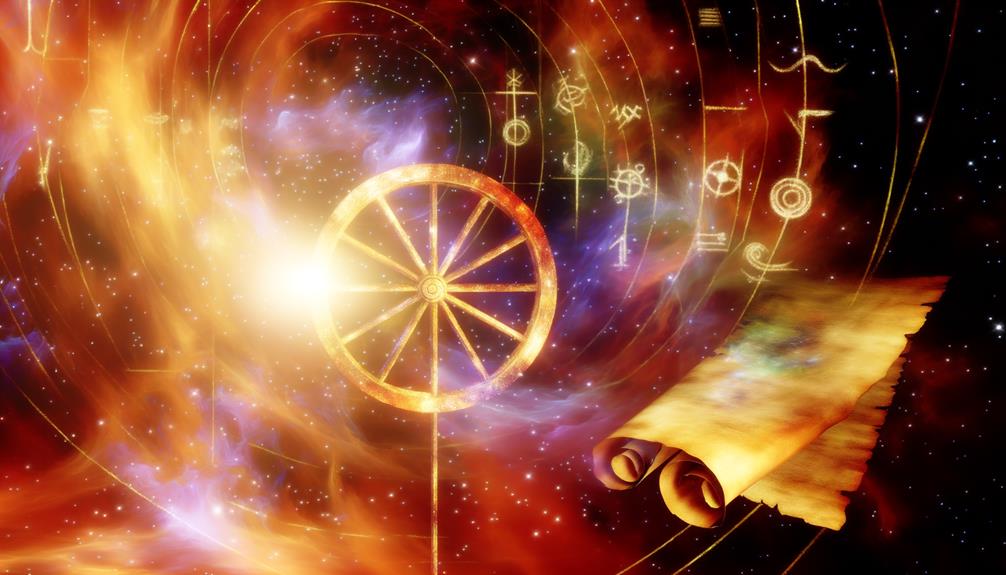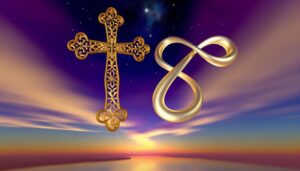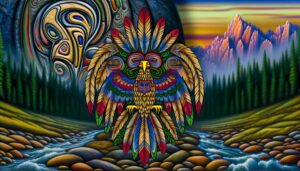How Does the Wheel of Fortune Symbolize Meaning in Popular Culture?
The Wheel of Fortune symbol represents the cyclical and unpredictable nature of life, deeply rooted in ancient Roman and Greek mythology. Associated with the goddess Fortuna, it signifies the capricious turns of fate.
In tarot, it illustrates the interplay between destiny and free will, highlighting transformative moments and the concept of karma. Across cultures, it embodies the transient nature of human affairs and the necessity of adaptability.
The symbol emphasizes the importance of resilience and the acceptance of life's constant ebb and flow. Exploring its rich cultural and philosophical contexts can provide profound insights into existence.

Key Takeaways
- Symbolizes the cyclical nature of fate and life's unpredictability.
- Represents the interplay between destiny and free will.
- Highlights the importance of adaptability and resilience.
- Emphasizes the transient nature of fortune and change.
- Reflects the concept of karma and past actions shaping future outcomes.
Historical Origins

The historical origins of the Wheel of Fortune symbol can be traced back to ancient Roman and Greek mythology, where it was primarily associated with the capricious nature of fate and the goddess Fortuna. This emblematic wheel represented the unpredictable turns of fortune, reflecting the belief that human destiny was subject to the whims of higher powers.
In both Roman and Greek cultures, the wheel was a powerful metaphor for the cyclical nature of life, encompassing prosperity, adversity, and the inevitable oscillations between the two. The concept encapsulated a worldview where stability was transient, and change was the only constant.
This ancient symbolism has endured through centuries, influencing medieval philosophy and permeating various cultural and literary traditions, underscoring the timeless allure of the Wheel of Fortune.
Mythological Significance
The mythological significance of the Wheel of Fortune is deeply intertwined with ancient deities such as the Roman goddess Fortuna, who personified luck and chance.
This symbol has historically been a powerful representation of the ever-changing nature of fate and destiny, reflecting the belief that life's fortunes are perpetually in flux.
Ancient Deity Association
Rooted in the annals of mythology, the Wheel of Fortune is often intertwined with the capricious nature of ancient deities who controlled fate and destiny.
In Roman mythology, Fortuna, the goddess of fortune and the personification of luck, wielded a wheel that symbolized the unpredictable nature of life.
Similarly, in Greek mythology, the Moirai, or Fates, were believed to spin, measure, and cut the threads of human lives, further emphasizing the wheel as a symbol of life's cyclical and uncontrollable aspects.
The Norse mythology introduces Norns, akin to the Fates, who dictated the destiny of gods and men. These associations underscore the wheel's enduring representation of life's inherent instability and the whims of divine forces.
Fate and Destiny
Interwoven with the mythological narratives of ancient civilizations, the concept of fate and destiny emerges as a central theme, manifesting through the allegorical Wheel of Fortune to illustrate life's inherent unpredictability and the influence of supernatural forces.
The Wheel of Fortune, a ubiquitous symbol in myth and literature, encapsulates the cyclical nature of existence and the inevitability of change, governed by forces beyond human control. This motif underscores the transient nature of fortune, where individuals ascend and descend in accordance with destiny's whim.
Key mythological interpretations include:
- Greek Moirai: The three Fates who control the thread of life.
- Roman Fortuna: Goddess of chance and fortune.
- Hindu Kala Chakra: Represents the eternal cycle of time.
- Norse Norns: Beings who shape destiny.
Symbolism in Tarot

The Wheel of Fortune card, situated within the Major Arcana, holds profound implications, symbolizing the perpetual motion of cycles and change that govern existence.
It poignantly illustrates themes of fate and destiny, indicating the inevitable ebb and flow that shapes the human experience.
This card serves as a powerful reminder of the interplay between external forces and personal agency, urging contemplation on the balance between control and surrender.
Major Arcana Significance
In tarot, the Wheel of Fortune card, a pivotal symbol within the Major Arcana, represents the cyclical nature of fate and the perpetual motion of life's events. This card underscores the profound interplay between destiny and free will, symbolizing the inevitability of change. As a Major Arcana card, it holds significant weight in a reading, often highlighting transformative moments or turning points. The Wheel of Fortune is also associated with the concept of karma, suggesting that the outcomes we experience are tied to our past actions.
- Symbolic Imagery: Depicts a wheel with various mystical creatures, each representing different aspects of life.
- Astrological Associations: Often linked with Jupiter, the planet of expansion and luck.
- Numerical Significance: Number 10, symbolizing completion and new beginnings.
- Interconnectedness: Emphasizes the link between individual actions and larger cosmic forces.
Cycles and Change
Cycles and change in tarot symbolism reflect the inherent fluidity of existence, illustrating how life's phases are in constant motion and metamorphosis.
The Wheel of Fortune card epitomizes this concept, depicting a wheel that turns perpetually, signifying the inevitable ebb and flow of life's events. Each segment of the wheel can represent different stages or shifts, from prosperity to adversity and back again.
This cyclical nature underscores the importance of adaptability and resilience, encouraging individuals to embrace change rather than resist it. The card serves as a potent reminder that nothing is permanent; circumstances evolve, and so must we.
Understanding this dynamic helps to foster a deeper acceptance of life's unpredictable nature, promoting personal growth and awareness.
Fate and Destiny
Acknowledging the cyclical nature of life, the Wheel of Fortune card also profoundly explores the themes of fate and destiny, illustrating how unseen forces and predetermined paths influence human experiences.
This card serves as a reminder of the interconnectedness of all events, beyond human control. The symbolism embedded in the Wheel of Fortune suggests that life is a tapestry woven with threads of both destiny and chance, urging reflection on the balance between free will and fate.
Key symbolic elements include:
- The Wheel: Represents the perpetual cycle of life, fortune, and change.
- Four Creatures: Symbolize the astrological signs, indicating cosmic influences.
- Sphinx: Embodies enigma and wisdom, hinting at the mysteries of fate.
- Angels and Books: Signify divine knowledge and the recording of destiny.
Cultural Variations
The symbolic significance of the Wheel of Fortune varies across cultures, reflecting diverse beliefs and interpretations rooted in historical, philosophical, and spiritual contexts.
In ancient Greece, it represented the capricious nature of the gods, where fortune could rise or fall unpredictably.
In medieval Europe, it symbolized the transient nature of human affairs, encapsulated in the concept of Rota Fortunae, where one's fate is subject to the whims of Fortune.
The Hindu and Buddhist traditions view the wheel as a representation of karma and the cyclical nature of life, death, and rebirth.
These cultural variations underscore the universal yet multifaceted nature of the Wheel of Fortune, highlighting how different societies conceptualize the interplay between destiny and human agency.
Philosophical Interpretations

The Wheel of Fortune symbol profoundly encapsulates the philosophical themes of cycles and change, reflecting life's inherent unpredictability and the inevitability of transformation.
It also addresses the concepts of fortune and destiny, suggesting that one's fate may be subject to forces beyond individual control.
Additionally, the symbol aligns with the Eternal Recurrence Theory, proposing the idea of time as an infinite loop where events perpetually repeat, offering a complex perspective on existence and human experience.
Cycles and Change
Examining the Wheel of Fortune symbol reveals profound insights into the philosophical concepts of cycles and change, emphasizing the inevitable ebb and flow of life's circumstances. This emblem underscores the transient nature of existence, where periods of success and adversity follow one another in an unending loop.
Philosophical interpretations of the Wheel often focus on its reminder that:
- Impermanence: All states, whether favorable or unfavorable, are temporary.
- Karma: Actions influence future outcomes, contributing to the cyclical nature of life.
- Acceptance: Embracing change can lead to inner peace and resilience.
- Perspective: Shifts in fortune encourage a broader understanding of life's holistic journey.
Through these lenses, the Wheel of Fortune becomes a profound symbol, urging individuals to navigate life's vicissitudes with wisdom and equanimity.
Fortune and Destiny
In contemplating the philosophical interpretations of Fortune and Destiny, one can discern a nuanced interplay between predetermination and free will, where the Wheel of Fortune serves as a metaphor for the unpredictable forces shaping human existence.
This symbol encapsulates the ancient belief that life's outcomes are governed not merely by human actions but also by an enigmatic, transcendent force. It suggests that while individuals endeavor to exert control over their lives, there exists an inherent unpredictability that can alter their paths.
The Wheel's rotation exemplifies the vicissitudes of fate, highlighting how fortune can elevate or diminish one's status without warning. This duality underscores an existential tension, inviting reflection on the extent to which destiny is malleable or fixed.
Eternal Recurrence Theory
Drawing from Nietzsche's philosophical postulations, Eternal Recurrence posits that existence and all events within it perpetually repeat in an infinite loop, challenging conventional perceptions of linear time and progress. This theory suggests that every moment in life, from the mundane to the monumental, will recur infinitely.
Such a concept invites deep introspection about the significance and impact of one's actions.
Key points of Eternal Recurrence include:
- Transformation of Existential Meaning: Encourages individuals to live authentically, knowing their actions will recur eternally.
- Rejection of Linear Progress: Contradicts the notion of historical or personal advancement.
- Psychological Implications: Raises questions about acceptance and resilience in the face of inevitable repetition.
- Ethical Considerations: Prompts moral reflection on decisions if faced with their eternal recurrence.
Depictions in Art
Throughout history, artists have intricately woven the Wheel of Fortune symbol into their works, using it to explore themes of fate, destiny, and the cyclical nature of life. In medieval manuscripts, it often appears as a stark reminder of life's unpredictability, with figures rising and falling along its rim.
Renaissance artists, such as Raphael, depicted the Wheel to emphasize human vulnerability against the forces of fortune. In more contemporary art, the symbol serves as a critique of societal structures and the illusion of control. Each depiction, whether in a painting, sculpture, or print, transforms the Wheel into a powerful visual metaphor, compelling viewers to reflect on the ephemeral and often tumultuous journey of existence.
Religious Perspectives

From ancient mythologies to organized religions, the Wheel of Fortune symbol has been imbued with profound spiritual significance, often representing the divine orchestration of life's cycles and the inherent uncertainty of human existence.
In Hinduism, it mirrors the concept of karma, where one's actions influence future outcomes.
In Buddhism, the Dharmachakra or Wheel of Dharma symbolizes the path to enlightenment and the cyclical nature of life, death, and rebirth.
- Hinduism: Reflects karma and the cyclical nature of existence.
- Buddhism: Represents the Wheel of Dharma, spiritual progression.
In Medieval Christianity, it illustrates the rise and fall of human fortune under divine providence.
In Ancient Greece, the Wheel of Fortune is associated with Tyche, the goddess of fortune, symbolizing the unpredictability of fate.
This intricate symbolism underscores the universal quest for understanding life's ebb and flow.
Literary References
Often woven into the fabric of narrative arcs, the Wheel of Fortune symbol permeates literary works to illustrate the tumultuous and unpredictable nature of human existence. This emblematic motif is prominently featured in texts such as Geoffrey Chaucer's 'The Canterbury Tales' and William Shakespeare's 'King Lear.'
In these works, the wheel's rotation signifies the capricious shifts of fate and fortune that characters endure, reflecting the duality of human experience—prosperity and despair. Chaucer's tales use the wheel to underscore the transient nature of worldly success, while Shakespeare's tragedies emphasize its role in human suffering and redemption.
Through these literary references, the Wheel of Fortune serves as a poignant reminder of life's inherent uncertainty and the perpetual cycle of change.
Psychological Insights

The Wheel of Fortune symbol offers profound psychological insights into the human condition, encapsulating the inherent uncertainty and variability of life's experiences. This archetypal image, often depicted in Tarot cards, serves as a powerful metaphor for the cyclical nature of human existence. It reflects the following key psychological dimensions:
- Unpredictability: The wheel's constant motion signifies the unpredictable changes in fortunes, prompting individuals to adapt.
- Resilience: Understanding that setbacks are temporary encourages mental resilience and emotional flexibility.
- Perspective: The wheel's rotations remind us to maintain perspective, recognizing that highs and lows are transient.
- Acceptance: Embracing the wheel's symbolism fosters acceptance of life's inherent uncertainties, reducing anxiety.
These insights collectively contribute to a richer understanding of human psychology, emphasizing adaptability and acceptance.
Modern-Day Relevance
In today's fast-paced and ever-changing world, the Wheel of Fortune symbol remains profoundly relevant as a metaphor for journeying through life's uncertainties and changes. This ancient symbol encapsulates the cyclical nature of existence, reflecting the unpredictability inherent in modern life.
As technology and globalization accelerate the pace of change, individuals frequently encounter unexpected shifts in career, relationships, and personal growth. The Wheel of Fortune encourages a mindset of adaptability and resilience, reminding us that highs and lows are integral parts of the human experience.
Lessons on Fate

A profound lesson imparted by the Wheel of Fortune symbol is the intricate interplay between fate and personal agency, prompting deep reflection on the extent to which life's outcomes are predetermined or influenced by individual actions.
This symbol serves as a reminder of the cyclical nature of existence, emphasizing that change is the only constant. It invites contemplation on the following aspects:
- Unpredictability: Life's events often unfold in unexpected ways, challenging our sense of control.
- Resilience: Adapting to the highs and lows of life's cycles fosters growth and strength.
- Acceptance: Recognizing the limits of our influence encourages peace with the uncontrollable.
- Intentionality: While fate plays a role, deliberate actions can still shape one's path.
Such reflections enrich our understanding of life's complex dynamics.
Conclusion
The Wheel of Fortune symbol, with its rich historical origins and diverse cultural interpretations, encapsulates the ever-changing nature of fate and fortune.
Its presence in mythology, tarot, and literature underscores a universal recognition of life's cyclical patterns.
The philosophical and psychological insights it offers reveal humanity's enduring quest to understand destiny's fluctuations.
Modern-day relevance further attests to its timeless applicability, suggesting that embracing the wheel's lessons can foster resilience and adaptability in the face of life's unpredictability.





